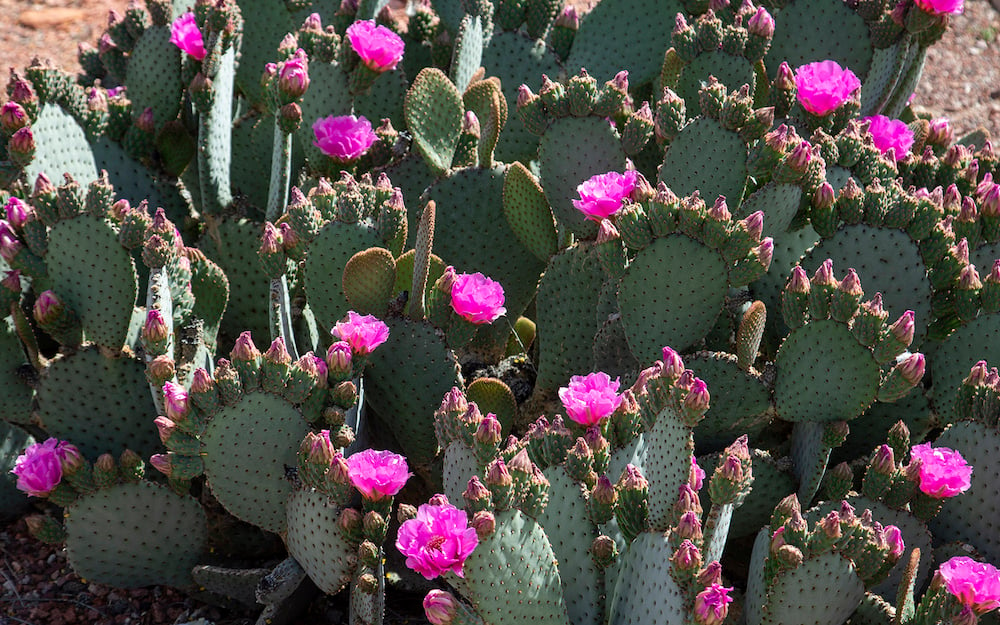The prickly pear cactus, with its flat, segmented pads and resilient nature, is a master of survival in arid environments. Its adaptations for water conservation, heat tolerance, and even edibility offer valuable insights for creating sustainable and functional desert homes.
1. Flat Pads and Efficient Solar Capture:
- The prickly pear's flat, segmented pads maximize surface area for photosynthesis while minimizing water loss.
- Architectural Application:
- We can design homes with flat, layered roofs or walls that maximize solar capture for photovoltaic panels or solar water heating.
- Incorporate shading systems with flat, horizontal elements that mimic the prickly pear's pads, providing shade and reducing heat gain.
- Design courtyards and patios with flat, paved surfaces that collect and radiate heat, creating comfortable outdoor spaces.
- Example:
- A home could feature a flat roof with integrated photovoltaic panels, maximizing solar energy production. Horizontal shading elements, resembling prickly pear pads, could provide shade for the south-facing windows. A paved patio could radiate heat at night, creating a comfortable outdoor space.
2. Spines and Natural Defense:
- The prickly pear's sharp spines provide a natural defense against herbivores and create a protective barrier.
- Architectural Application:
- We can design exterior shading systems and security features that mimic the prickly pear's spines. Perforated metal screens, trellises with thorny climbing vines, and strategically placed thorny xeriscape plants can create a protective barrier.
- The use of layered landscaping with varied plant heights and textures can also provide a sense of security and privacy.
- Example:
- A home could feature perforated metal screens with a sharp, geometric pattern, resembling the prickly pear's spines, that provide shade and security. Thorny ocotillo and cholla plants could be strategically placed around the perimeter.
3. Water Storage and Succulent Design:
- The prickly pear's fleshy pads store water, allowing it to survive prolonged periods of drought.
- Architectural Application:
- We can design homes with integrated rainwater harvesting systems, channeling water into cisterns or underground storage.
- Use thick, high-thermal-mass walls, mimicking the prickly pear's water-storing pads, to regulate indoor temperatures.
- Design courtyards and recessed patios that collect and retain moisture.
- Incorporate green roofs and living walls using drought-tolerant succulents, echoing the prickly pear's form and function.
- Example:
- A home could feature thick adobe walls that absorb and release heat, much like the prickly pear's pads store water. A central courtyard with a sunken garden could collect rainwater and create a cool microclimate. A green roof planted with various succulents, including prickly pear varieties, would provide insulation and visual appeal.
4. Edibility and Sustainable Living:
- The prickly pear's pads and fruits are edible, providing a valuable food source in arid environments.
- Architectural Application:
- We can incorporate edible landscaping into our desert home designs, using prickly pear and other drought-tolerant fruit-bearing plants.
- Design outdoor kitchens and patios that facilitate food preparation and consumption.
- Create community gardens or shared spaces for growing and harvesting food.
- Example:
- A home could feature a xeriscape garden with prickly pear, pomegranate, and other edible desert plants. An outdoor kitchen and patio could provide a space for cooking and enjoying the harvest. A shared community garden could foster a sense of community and promote sustainable living.
5. Adaptability and Resilience:
- The prickly pear's ability to thrive in a variety of soil types and climates makes it a highly adaptable and resilient species.
- Architectural Application:
- We can design homes with flexible and adaptable spaces that can be easily modified to meet changing needs.
- Use locally sourced and durable materials that are well-suited to the desert environment.
- Design for passive heating and cooling, to minimize reliance on mechanical systems.
- Example:
- A home could feature modular interior walls that can be easily reconfigured. The home could be constructed from locally sourced rammed earth, providing thermal mass and durability. Passive solar design strategies could minimize the need for air conditioning.
Conclusion:
By studying the prickly pear cactus, we can design desert homes that are not only comfortable but also sustainable, resilient, and resourceful. Its adaptations for solar capture, natural defense, water storage, edibility, and adaptability offer valuable lessons for creating dwellings that thrive in the arid landscape. By embracing biomimicry, we can build homes that are both functional and beautiful, reflecting the wisdom of the desert ecosystem and creating harmonious living spaces.




Leave a Comment